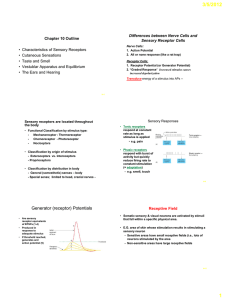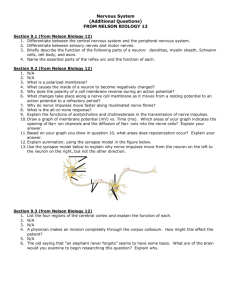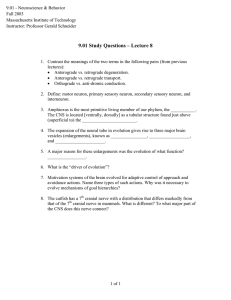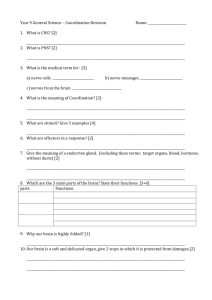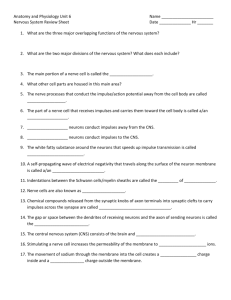5/1/2012 Sensory Systems – Chapter 22
advertisement
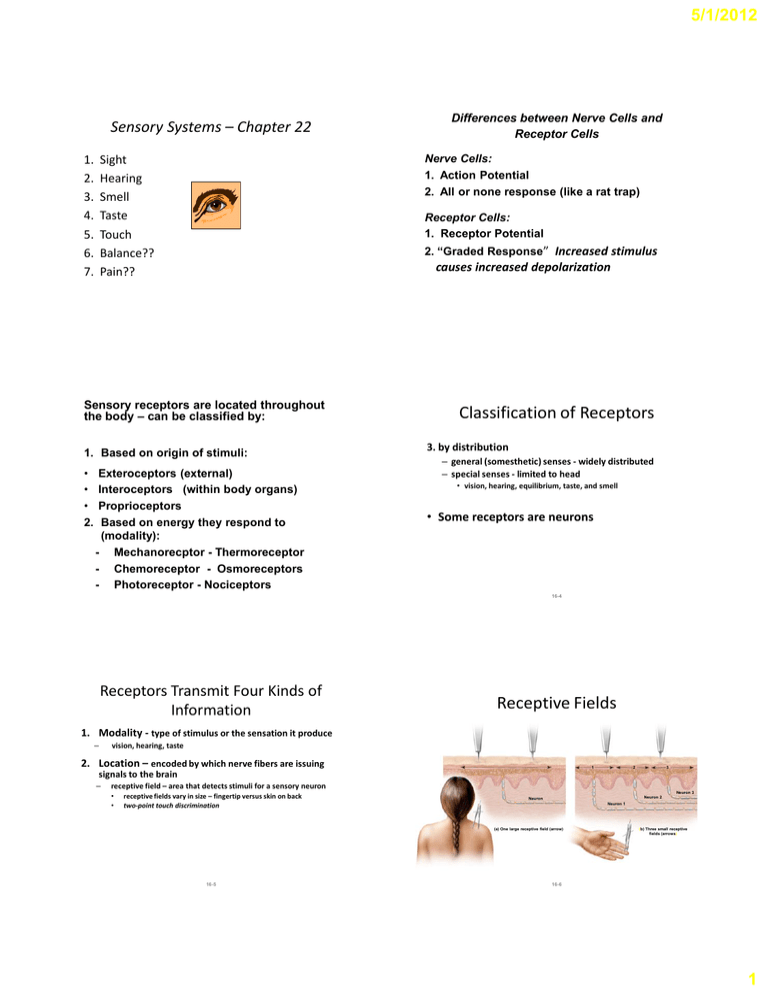
5/1/2012 Sensory Systems – Chapter 22 1. 2. 3. 4. 5. 6. 7. Sight Hearing Smell Taste Touch Balance?? Pain?? Nerve Cells: 1. Action Potential 2. All or none response (like a rat trap) Receptor Cells: 1. Receptor Potential 2. “Graded Response” Increased stimulus causes increased depolarization Sensory receptors are located throughout the body – can be classified by: 1. Based on origin of stimuli: • • • 2. Differences between Nerve Cells and Receptor Cells Exteroceptors (external) Interoceptors (within body organs) Proprioceptors Based on energy they respond to (modality): - Mechanorecptor - Thermoreceptor - Chemoreceptor - Osmoreceptors - Photoreceptor - Nociceptors Classification of Receptors 3. by distribution – general (somesthetic) senses - widely distributed – special senses - limited to head • vision, hearing, equilibrium, taste, and smell • Some receptors are neurons 16-4 Receptors Transmit Four Kinds of Information Receptive Fields 1. Modality - type of stimulus or the sensation it produce – vision, hearing, taste 2. Location – encoded by which nerve fibers are issuing 1 2 3 signals to the brain – receptive field – area that detects stimuli for a sensory neuron • • receptive fields vary in size – fingertip versus skin on back two-point touch discrimination Neuron 3 Neuron 2 Neuron Neuron 1 (a) One large receptive field (arrow) 16-5 (b) Three small receptive fields (arrows) 16-6 1 5/1/2012 Receptors Transmit Four Kinds of Information 3. Intensity – • • • which fibers are sending signals how many fibers are firing how fast these fibers are firing 4. Duration – how long the stimulus lasts 1. phasic receptor – generate a burst of action potentials when first stimulated, then quickly adapt and sharply reduce or stop signaling even though the stimulus continues • 2. smell, hair movement, and cutaneous pressure tonic receptor - adapt slowly, generate nerve signals more steadily • proprioceptors - body position, muscle tension, and joint motion Fig.41.8 16-7 Vestibule (Utricle & Saccule) Bony labyrinth Saccule and Utricle - macula Macula 41.6 2 5/1/2012 Endolymph Turning Movements Change in direction Gravity and speed 41-6 Vestibular apparatus Another Mechanoreceptor - Auditory receptors in the cochlea endolymph - Hair cells respond to pressure waves (sound waves) Vibrations Fluid in cochlea Basilar membrane vibrates Hair cells are stimulated Info. to brain 41.7 Fig.41.8 3 5/1/2012 scala vestibuli Vestibular membrane Cochlear duct scala tympani Organ of corti Fig.41.9 Scala vestibuli Vestibular Membrane Scala tympani Fig. 41.9 Cochlear nerve, division of the vestibulocochlear (VIII) nerve Oral window (a) Please note that due to differing operating systems, some animations will not appear until the presentation is viewed in Presentation Mode (Slide Show view). You may see blank slides in the “Normal” or “Slide Sorter” views. All animations will appear after viewing in Presentation Mode and playing each animation. Most animations will require the latest version of the Flash Player, which is available at http://get.adobe.com/flashplayer. Organ of Corti Vestibular canal (contains perilymph) Vestibular membrane Cochlear duct (contains endolymph) Vestibular canal Tectorial membrane Tectorial membrane Organ of Corti Basilar membrane (b) Cochlear duct Cilia Tympanic canal (contains perilymph) Force Hair cell Cochlear nerve Basilar membrane Fluid vibrations Tympanic canal (c) Fig.41.08 4 5/1/2012 Gustatory Sensation: Taste Chemoreceptors: Sesory receptors that respond to chemicals • Taste requires dissolving of substances • Four classes of stimuli-sour, bitter, sweet, and salty • 10,000 taste buds found on tongue, soft palate & larynx • Found on sides of circumvallate & fungiform papillae • 3 cell types: supporting, receptor & basal cells • Taste (gustation) (taste buds) • Smell (olfaction) (olfactory cells) Dad!! Flavor Flav!! Umami Taste bud: 1. Support cells 2. Gustatory receptor cells 3. Basal cells Meaty/savory Adaptation???? Olfactory epithelium tapetum lucidum cilia Fig. 41.6 5 5/1/2012 Tunics (Layers) of Eyeball • Fibrous Tunic (cornea, sclera) • Vascular Tunic (choroid, ciliary body, iris, pupil) • Nervous Tunic (Retina) Fig.41.16 Rods = dim light Cones = color Red – green – blue cones Layers of Retina • Pigmented epithelium – nonvisual portion – absorbs stray light & helps keep image clear • 3 layers of neurons (outgrowth of brain) – photoreceptor layer – bipolar neuron layer – ganglion neuron layer • 2 other cell types (modify the signal) – horizontal cells – amacrine cells Fig. 41-18 6 5/1/2012 Generating the Optic Nerve Signal Rhodopsin Bleaching/Regeneration In the dark In response to light: 1. 11-cis converts to all-trans 2. it dissociates from opsin 3. This changes ion permeability of rod plasma membrane 4. Nerve implulse in ganglion c. In the light Opsin 6 Opsin and cis-retinal enzymatically combine to regenerate rhodopsin Disc Cell membrane 1 Rhodopsin absorbs photon of light cis-retinal Figure 16.37 (b) 5 Trans-retinal is enzymatically converted back to cis-retinal 2 Cis-retinal isomerizes to trans-retinal Pigment molecule CH3 C H2C C (c) Pigment molecule 3 Opsin triggers reaction cascade that breaks down cGMP (e) CH3 H C C H2C C CH HC O Retinal Cessation of dark current H2C C H2C C C C H CH3 H C C H H C C C H C H O C CH3 H2 CH3 (a) (d) (f) Visual cycle of retinal 16-37 CH3 H C C Opsin Signals created in optic nerve Trans-retinal (bleached) 16-38 Generating Visual Signals 1 Rhodopsin absorbs no light CH C H C CH3 H3C H2 CH3 Cis-retinal CH3 4 Trans-retinal separates from opsin H C C C H Electrical Activity of Retinal Cells • Rods and cones contain many Na+ channels that are open in dark 1 Rhodopsin absorbs light – This depolarizing Na+ influx is the dark current – depolorized they release an inhibitory NT. Rod cell • Light cause Na+ channels to close 2 Rod cell releases glutamate 3 Bipolar cell inhibited – cells become hyperpolarized!!!!! – quit releasing inhibitory NT – Bipolar cell no longer inhibited – released excitatory NT 2 Glutamate secretion ceases Bipolar cell 3 Bipolar cell no longer inhibited 4 Bipolar cell releases neurotransmitter 4 No synaptic activity here Ganglion cell 5 No signal in optic nerve fiber 5 Signal in optic nerve fiber (a) In the dark (b) In the light 16-39 10-82 Electrical Activity of Retinal Cells Phototransduction 10-83 Figure 15.18 7 5/1/2012 Generating Visual Signals 1 Rhodopsin absorbs no light 1 Rhodopsin absorbs light Rod cell 2 Rod cell releases glutamate 3 Bipolar cell inhibited 2 Glutamate secretion ceases Bipolar cell 3 Bipolar cell no longer inhibited 4 Bipolar cell releases neurotransmitter 4 No synaptic activity here Ganglion cell 5 No signal in optic nerve fiber 10-84 (a) In the dark 5 Signal in optic nerve fiber 16-44 (b) In the light Brain Pathways of Vision 8
